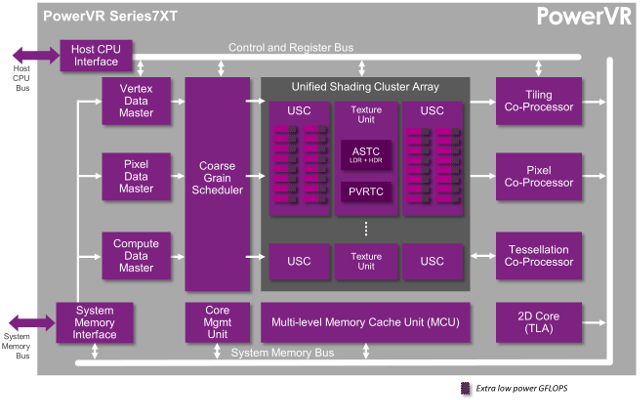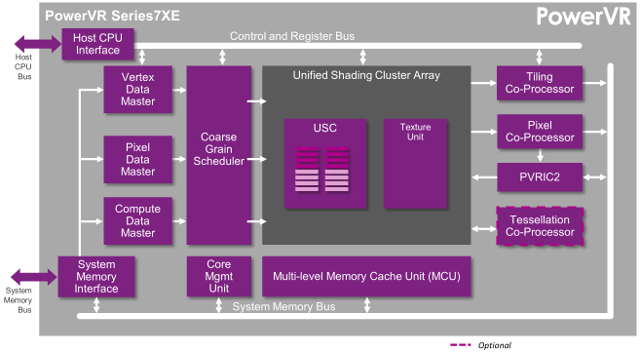Imagination Technologies has announced a new PowerVR Series7 GPU architecture that will be used in their high end PowerVR Series7XT GPUs delivering up to 1.5 TFLOPS for mid range and high-end mobioe devices, set-top boxes, gaming consoles and even servers, as well as their low power lost cost PowerVR Series7XE GPUs for entry-level mobile devices, set-top boxes, and wearables.

PowerVR Series7 GPU, both Series7XT and Series7XE GPUs, can achieve up to a 60% performance improvement over PowerVR Series6XT/6XE GPUs for a given configuration. For example a 64-core PowerVR7XT GPU should be up to 60% faster than a 64-core PowerVR Series6XT clocked at the same frequency, with all extra performance due to a different and improved architecture.
Some of Series7 architectural enhancements include:
- Instruction set enhancements including added co-issue capability, resulting in improved application performance and increased GPU efficiency
- New hierarchical layout structure that enables scalable polygon throughput and pixel fillrate improvements in addition to increased clock frequencies
- GPU compute setup and cache throughput improvements resulting in up to 300% better parallel processing performance
The new GPUs can also optional support 10-bit YUV color depths, security (e.g. DRM), and hardware virtualization, as well as other feature specific to some market segments:
- Android Extension Pack (AEP) – Full hardware tessellation and native OpenGL ES 3.1 support. Compatible with Android 5.0 ‘Lollipop’ release.
- DirectX 11 Feature Pack – Full DirectX 11.2 feature set for Microsoft operating systems.
- OpenCL FP64 Feature Pack – Scalable 64-bit floating point co-processor per cluster for high-performance server compute. Series7XT only.

The PowerVR Series7XT family scales between 100 GFLOPS to 1.5 TFLOPS, and is designed to provide the best possible performance. It features AEP and 10-bit YUV support by default, and supports between two to sixteen clusters with 32 multi-threaded multi-tasking ALU cores each. Current Series7XT GPUs include the GT7200 (64 cores), GT7400 (128 cores), GT7600 (192 cores), GT7800 (256 cores), and GT7900, the most powerful PowerVR GPU to date with 512 cores.
On the other hand, Series7XE GPUs are optimized for area, efficiency, and cost thanks to feature configurability, with let SoC manufacturers choose whether they want options such as 10-bit YUV support for HEVC, virtualization, or AEP support. Beside low cost mobile devices and media player, Series7XE GPU are also expected to be used in photocopiers, printers, consumer and other enterprise devices which may require 3D user interfaces at a lower price point. There are two GPUs part of the Series7XE family: GE7400 with 16 cores, and the GE7800 with 32 cores.
The company will provide their usual free PowerVR SDK for 3D graphics and GPU compute application development. Hypervisors will be able to utilize the virtualization in the GPUs to implement true heterogeneous security in any of the PowerVR Series7 GPUs (if virtualization is enabled).
PowerVR Series7XE and Series7XT GPUs are available for licensing now, and Imagination Technologies has already started implemention their new GPU IP into SoCs from licensing partners. More technical details about be found on two blog post: New PowerVR Series7XE family targets the next billion mobile and embedded GPUs and PowerVR Series7XT GPUs push graphics and compute performance to the max.

Jean-Luc started CNX Software in 2010 as a part-time endeavor, before quitting his job as a software engineering manager, and starting to write daily news, and reviews full time later in 2011.
Support CNX Software! Donate via cryptocurrencies, become a Patron on Patreon, or purchase goods on Amazon or Aliexpress




